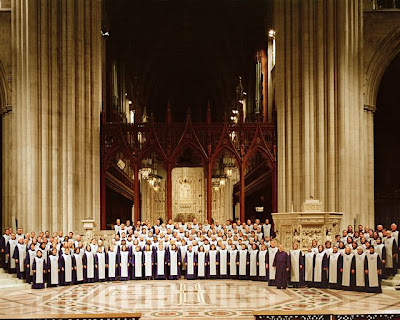 Dominick Argento and J. Reilly Lewis photo courtesy of Cathedral Choral Society |
It galls me as a Catholic and a medieval historian that the Anglicans are more faithful to the Divine Office than the modern Catholic church. Vespers (Evensong) is a venerable and living tradition in the Episcopalian church, and that is the background of this new oratorio, which follows the basic outline of the service in the Book of Common Prayer. That being said, Argento has chosen once again to write his own texts for the work, in some cases modifying liturgical texts and in others creating new ones.
The results of that approach were mixed. Liturgical and Biblical texts are solid, proven over centuries and weighted with significance beyond the simple content of their meaning. While Evensong is no doubt a sincere expression of the love Argento shared with his late wife, the newly composed parts of the libretto pale in comparison, coming dangerously close to the sentiments of a Hallmark card. For example, the Sermon movement concludes, "Yes, we are mere mortals and this gift of light comes at the cost of everything we are, and all that we will ever be. Giving it is the greatest blessing within our power. To give it is to be -- for a little while at least -- among the Angels." It is true to the tone of many homilists and thus comes off, like them, as hardly profound.
 The scriptural reading that provides the basis of Evensong is taken from the fifth chapter of the Gospel of John. Argento focuses on the sick and infirm crowds huddled around the pool of Bethsaida (Bethesda), waiting for the miraculous cure associated with that place in Jerusalem. According to a legend, an angel would descend to the place and stir up the water, after which the first person to step into the water would be healed. The hope for a miraculous cure for a terminal illness is what appealed to Argento, according to his note in the program (Argento's wife spent her final days in a Bethesda Rehabilitation Center in Minnesota). A fascination with that scene is found in art history, too, as in the beautiful painted doors by Veronese on the organ of San Sebastiano in Venice, for example.
The scriptural reading that provides the basis of Evensong is taken from the fifth chapter of the Gospel of John. Argento focuses on the sick and infirm crowds huddled around the pool of Bethsaida (Bethesda), waiting for the miraculous cure associated with that place in Jerusalem. According to a legend, an angel would descend to the place and stir up the water, after which the first person to step into the water would be healed. The hope for a miraculous cure for a terminal illness is what appealed to Argento, according to his note in the program (Argento's wife spent her final days in a Bethesda Rehabilitation Center in Minnesota). A fascination with that scene is found in art history, too, as in the beautiful painted doors by Veronese on the organ of San Sebastiano in Venice, for example.Tim Smith, 'Evensong' strikes a chord in Washington (Baltimore Sun, March 4) Joe Banno, Cathedral Choral Society (Washington Post, March 4) Karl Gehrke, New Argento work honors his late wife (Minnesota Public Radio, February 28) |
The liturgical context is rich, to be sure, of which only the surface has been scratched in Evensong. Musically, Argento's score was in the largely neoclassical style we have come to expect from him, with dissonances ranging from lush to acerbic almost always resolving to triads and perfect intervals. A striking main theme pervades the work, with its first three notes based on Argento's late wife's initials, C-B-A (that is, down a minor second and up a minor seventh). It opens the work, stated by a solo oboe in the first bars of the orchestral Threnody. It is answered by a solo viola, and then it descends into the bass instruments, starting a half-step lower at each appearance. A series of chords based on the three-note motif (C major, B major, A major) is heard many times, too, and actually concludes the final movement, hovering in the distance over a D pedal point, denying a final sense of resolution.
 Elizabeth Futral, photo by Christian Steiner |
Conductor J. Reilly Lewis is to be commended for succeeding in bringing Argento back to composition (WETA-FM has released an MP3 file containing a conversation with Argento and Lewis, led by Deb Lamberton) and for celebrating the National Cathedral centenary in such a magnificent way. The concert opened with a less successful rendition of Mozart's Vesperae Solennes de Confessore, K. 339. From my initial seat in the north transept, the large chorus and orchestra seemed more at odds than not, and the solo vocal quartet, who stood at the edge of the crossing facing down the nave, could barely be heard. The main reason to care about this piece at all is the Laudate Dominum movement, which Elizabeth Futral sang with beautiful clarity, but the Laudate pueri dominum movement has some worthy and unusual music, too. It was a nice touch to have William Culverhouse's Gregorian schola from the Catholic cathedral of Washington, St. Matthew's, to sing the opening and closing versicles and the Latin antiphons that introduced each of Mozart's psalm (and Magnificat) settings.
WETA (90.9 FM) recorded this concert for broadcast at a future date, and the live recording will be released commercially. The final performance of the Cathedral Choral Society's season will feature Mendelssohn's Elijah (May 18, 4 pm).
No comments:
Post a Comment